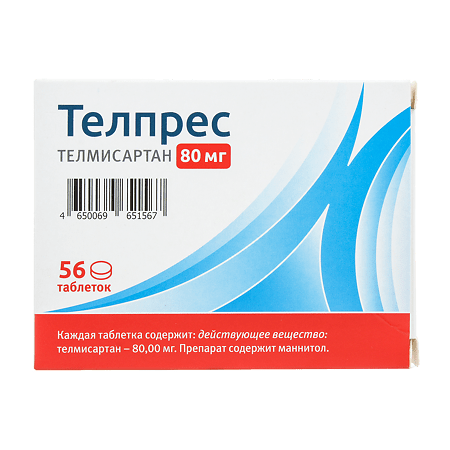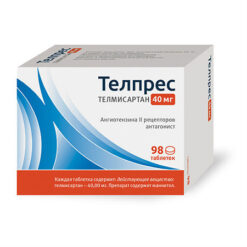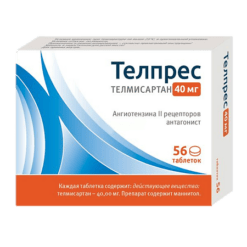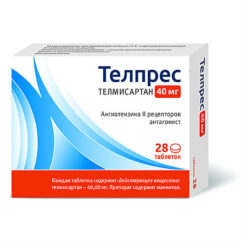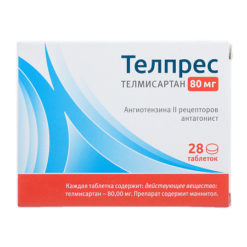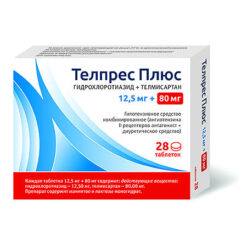No products in the cart.
Telprez, tablets 80 mg 56 pcs
€1.00
Out of stock
(E-mail when Stock is available)
Description
Pharmacotherapeutic group: Angiotensin II receptor antagonist
ATX: C.09.C.A.07
Pharmacodynamics:
Telmisartan is a specific angiotensin II receptor antagonist (type AT1), effective when taken orally. It has a high affinity for the AT1 subtype of angiotensin II receptors, through which the action of angiotensin II is realized. It displaces angiotensin II from binding to the receptor, having no agonist effect against this receptor. Telmisartan binds only to the AT1 subtype of the angiotensin II receptor. The binding is long-lasting. It has no affinity for other receptors, including AT2 receptor and other less studied angiotensin receptors.
The functional significance of these receptors and the effect of their possible excessive stimulation by angiotensin II, whose concentration increases with telmisartan administration, have not been studied. It reduces the blood concentration of aldosterone, does not inhibit plasma renin and does not block ion channels. Telmisartan does not inhibit angiotensin-converting enzyme (kinininase II) (an enzyme that also degrades bradykinin). Therefore, no intensification of bradykinin-induced side effects is expected.
In patients with arterial hypertension, telmisartan at a dose of 80 mg completely blocks the hypertensive effects of angiotensin II. The onset of antihypertensive action is observed within 3 hours after the first oral administration of telmisartan. The action of the drug persists for 24 hours and remains significant up to 48 hours. Distinct antihypertensive effect usually develops in 4 weeks after regular drug intake.
In patients with arterial hypertension telmisartan reduces systolic and diastolic blood pressure (BP) without affecting heart rate (HR).
In the case of abrupt telmisartan withdrawal, BP gradually returns to baseline levels without the development of “withdrawal” syndrome.
Pharmacokinetics:
Absorption
When taken orally, it is rapidly absorbed from the gastrointestinal tract. Bioavailability is about 50%. When taken simultaneously with food AUC (area under the curve “concentration-time”) decreases from 6% (at a dose of 40 mg) to 19% (at a dose of 160 mg). Three hours after ingestion, plasma concentrations level off regardless of ingestion.
Distribution
Binding to plasma proteins is 99.5%, mainly to albumin and alpha-1 glycoprotein. Average apparent volume of distribution at equilibrium concentration is 500 l.
Metabolism
Metabolized by conjugation with glucuronic acid. Metabolites are pharmacologically inactive.
Excretion
The half-life (T1/2) is more than 20 hours. Excretion is via the intestine unchanged, excretion by the kidneys – less than 2% of the ingested dose. Total plasma clearance is high (900 ml/min) compared to “hepatic blood flow” (about 1500 ml/min).
Pharmacokinetics in special groups of patients
Gender differences
There is a difference in plasma concentrations in men and women. Cmax (maximum concentration) and AUC were approximately 3 and 2 times higher in women compared to men, respectively, with no significant effect on efficacy. No dose adjustment is required.
Elderly patients
Telmisartan pharmacokinetics in elderly patients does not differ from pharmacokinetics in younger patients. No dose adjustment is required.
Patients with impaired renal function
In patients with mild to moderate impaired renal function no dose adjustment of telmisartan is required.
Patients with severe renal impairment and patients on hemodialysis are recommended a lower starting dose of 20 mg per day.
Telmisartan is not excreted by hemodialysis.
Patients with hepatic impairment
Pharmacokinetics studies in patients with hepatic impairment have shown increased absolute bioavailability of telmisartan to almost 100%.
In hepatic insufficiency the T1/2 is not altered.
In patients with mild to moderate hepatic impairment (Child-Pugh grades A and B) the daily dose of the drug should not exceed 40 mg.
Indications
Indications
– Arterial hypertension;
– Reduce cardiovascular morbidity and mortality in patients aged 55 years and older with a high risk of cardiovascular disease.
Pharmacological effect
Pharmacological effect
Pharmacotherapeutic group: Angiotensin II receptor antagonist
ATX: C.09.C.A.07
Pharmacodynamics:
Telmisartan is a specific angiotensin II receptor antagonist (AT1 type), effective when taken orally. It has a high affinity for the AT1 subtype of angiotensin II receptors, through which the action of angiotensin II is realized. Displaces angiotensin II from its connection with the receptor, without having an agonist effect on this receptor. Telmisartan binds only to the AT1 subtype of angiotensin II receptors. The connection is long-term. It has no affinity for other receptors, including the AT2 receptor and other less studied angiotensin receptors.
The functional significance of these receptors, as well as the effect of their possible excessive stimulation by angiotensin II, the concentration of which increases with the administration of telmisartan, have not been studied. Reduces the concentration of aldosterone in the blood, does not inhibit renin in the blood plasma and does not block ion channels. Telmisartan does not inhibit angiotensin-converting enzyme (kininase II) (an enzyme that also breaks down bradykinin). Therefore, an increase in the side effects caused by bradykinin is not expected.
In patients with arterial hypertension, telmisartan at a dose of 80 mg completely blocks the hypertensive effect of angiotensin II. The onset of antihypertensive action is observed within 3 hours after the first oral administration of telmisartan. The effect of the drug lasts for 24 hours and remains significant for up to 48 hours. A pronounced antihypertensive effect usually develops 4 weeks after regular use of the drug.
In patients suffering from arterial hypertension, telmisartan reduces systolic and diastolic blood pressure (BP) without affecting heart rate (HR).
In case of abrupt withdrawal of telmisartan, blood pressure gradually returns to the initial level without the development of withdrawal syndrome.
Pharmacokinetics:
Suction
When taken orally, it is quickly absorbed from the gastrointestinal tract. Bioavailability is about 50%. When taken simultaneously with food, the reduction in AUC (area under the concentration-time curve) ranges from 6% (at a dose of 40 mg) to 19% (at a dose of 160 mg). 3 hours after administration, the concentration in the blood plasma levels out regardless of food intake.
Distribution
Communication with blood plasma proteins is 99.5%, mainly with albumin and alpha-1 glycoprotein. The average value of the apparent volume of distribution at equilibrium concentration is 500 l.
Metabolism
Metabolized by conjugation with glucuronic acid. Metabolites are pharmacologically inactive.
Removal
The half-life (T1/2) is more than 20 hours. It is excreted unchanged through the intestines, excretion by the kidneys is less than 2% of the dose taken. The total plasma clearance is high (900 ml/min) compared to the “hepatic blood flow” (about 1500 ml/min).
Pharmacokinetics in special groups of patients
Gender differences
There is a difference in plasma concentrations between men and women. Cmax (maximum concentration) and AUC were approximately 3-fold and 2-fold, respectively, higher in women compared to men, with no significant effect on efficacy. No dose adjustment is required.
Elderly patients
The pharmacokinetics of telmisartan in elderly patients does not differ from the pharmacokinetics in young patients. No dose adjustment is required.
Patients with impaired renal function
In patients with mild to moderate renal impairment, no dose adjustment of telmisartan is required.
For patients with severe renal impairment and patients on hemodialysis, a lower starting dose of 20 mg per day is recommended.
Telmisartan is not eliminated by hemodialysis.
Patients with liver dysfunction
Pharmacokinetic studies in patients with liver failure showed an increase in the absolute bioavailability of telmisartan to almost 100%.
In liver failure, T1/2 does not change.
In patients with mild to moderate liver dysfunction (class A and B on the Child-Pugh scale), the daily dose of the drug should not exceed 40 mg.
Special instructions
Special instructions
Liver dysfunction
The use of Telpres is contraindicated in patients with cholestasis, biliary obstruction or severe liver dysfunction (Child-Pugh class C) (see section “Contraindications”), since telmisartan is mainly excreted in the bile. It is assumed that in such patients the hepatic clearance of telmisartan is reduced. In patients with mild or moderate liver dysfunction (Child-Pugh class A and B), Telpres should be used with caution (see section “With caution”).
Renovascular hypertension
When treated with drugs acting on the RAAS, in patients with bilateral arterial stenosis or arterial stenosis of a single functioning kidney, the risk of severe arterial hypotension and renal failure increases.
Renal dysfunction and kidney transplantation
When using the drug Telpres in patients with impaired renal function, periodic monitoring of potassium and creatinine levels in the blood plasma is recommended. There is no clinical experience with the use of Telpres in patients who have recently undergone kidney transplantation.
Decreased circulating blood volume
Symptomatic arterial hypotension, especially after the first dose of Telpres, may occur in patients with low blood volume and/or sodium content in the blood plasma due to previous treatment with diuretics, restriction of salt intake, diarrhea or vomiting. Such conditions (fluid and/or sodium deficiency) must be eliminated before taking Telpres.
Dual blockade of the renin-angiotensin-aldosterone system
Concomitant use of telmisartan with aliskiren is contraindicated in patients with diabetes mellitus or renal failure (glomerular filtration rate less than 60 ml/min/1.73 m2) (see section “Contraindications”).
The simultaneous use of telmisartan and ACE inhibitors is contraindicated in patients with diabetic nephropathy (see section “Contraindications”).
As a result of inhibition of the RAAS, the following were observed: arterial hypotension, fainting, hyperkalemia and impaired renal function (including acute renal failure) in patients predisposed to this, especially with the combined use of several drugs that also act on this system. Therefore, double blockade of the RAAS (for example, while taking telmisartan with other RAAS antagonists) is not recommended.
In cases where vascular tone and renal function depend primarily on the activity of the RAAS (for example, in patients with chronic heart failure or kidney disease, including renal artery stenosis, or stenosis of the artery of a single kidney), the prescription of drugs that affect this system may be accompanied by the development of acute arterial hypotension, hyperazotemia, oliguria and, in rare cases, acute renal failure.
Primary aldosteronism
In patients with primary aldosteronism, treatment with antihypertensive drugs that act by inhibiting the RAAS is usually ineffective.
Aortic and mitral valve stenosis, hypertrophic obstructive cardiomyopathy
Caution must be exercised when using Telpres (as well as other vasodilators) in patients with aortic or mitral stenosis, as well as hypertrophic obstructive cardiomyopathy.
Hyperkalemia
Taking medications that act on the RAAS can cause hyperkalemia. In elderly patients, patients with renal failure or diabetes mellitus, patients also taking medications that increase plasma potassium levels, and/or patients with underlying medical conditions, hyperkalemia can be fatal.
When deciding on the concomitant use of drugs acting on the RAAS, it is necessary to assess the risk-benefit ratio.
The main risk factors for hyperkalemia that should be considered are:
– diabetes mellitus, renal failure, age (patients over 70 years old);
– combination with one or more drugs acting on the RAAS and/or potassium-containing nutritional supplements. Drugs or therapeutic classes of drugs that may cause hyperkalemia include potassium-containing salt substitutes, potassium-sparing diuretics, ACE inhibitors, angiotensin II receptor antagonists, nonsteroidal anti-inflammatory drugs (NSAIDs, including selective COX-2 inhibitors), heparin, immunosuppressants (cyclosporine or tacrolimus), and trimethoprim;
– intercurrent diseases, especially dehydration, acute heart failure, metabolic acidosis, renal dysfunction, cytolysis syndrome (for example, acute limb ischemia, rhabdomyolysis, major trauma).
Patients at risk are advised to carefully monitor the potassium content in the blood plasma (see section “Interaction with other drugs”).
Ethnic differences
ACE inhibitors, telmisartan, and other receptor antagonists appear to be less effective in lowering blood pressure in black patients than in other races, possibly due to a greater predisposition to decreased renin activity in these patient populations.
Other
As with the use of other antihypertensive drugs, an excessive decrease in blood pressure in patients suffering from ischemic cardiomyopathy or coronary heart disease can lead to the development of myocardial infarction or stroke.
Impact on the ability to drive vehicles. Wed and fur.:
No special clinical studies have been conducted on the effect of the drug on the ability to drive a car or use machinery. When driving a car and working with mechanisms that require increased concentration, caution should be exercised, since dizziness and drowsiness may rarely occur while taking telmisartan. At a temperature not exceeding 25 ° C.
Keep out of the reach of children!
Active ingredient
Active ingredient
Telmisartan
Composition
Composition
Active ingredient:
telmisartan – 80.00 mg;
Excipients:
sodium hydroxide – 6.70 mg,
povidone-K25 – 21.60 mg,
meglumine – 24.00 mg,
mannitol – 327.70 mg,
magnesium stearate – 8.00 mg,
crospovidone – 12.00 mg.
Contraindications
Contraindications
– Hypersensitivity to the active substance or auxiliary components of the drug;
– Pregnancy;
– Breastfeeding period;
– Obstructive diseases of the biliary tract;
– Severe liver dysfunction (class C on the Child-Pugh scale);
– Simultaneous use of Telpres with aliskiren in patients with diabetes mellitus and/or impaired renal function (glomerular filtration rate less than 60 ml/min/1.73 m2);
– Simultaneous use of ACE inhibitors in patients with diabetic nephropathy;
– Age up to 18 years (efficacy and safety have not been established).
With caution:
– Bilateral renal artery stenosis or stenosis of the artery of a single kidney;
– Impaired liver and/or kidney function (see section “Special instructions”);
– Condition after kidney transplantation (no experience of use);
– Decrease in circulating blood volume (CBV) due to previous diuretic therapy, restriction of salt intake, diarrhea or vomiting;
– Hyponatremia;
– Hyperkalemia;
– Chronic heart failure;
– Coronary heart disease;
– Stenosis of the aortic and mitral valve;
– Idiopathic hypertrophic subaortic stenosis (hypertrophic obstructive cardiomyopathy);
– Primary aldosteronism (efficacy and safety have not been established);
– Simultaneous use with ACE inhibitors or aliskiren;
– Simultaneous use with potassium preparations, potassium-sparing diuretics;
– Diabetes mellitus.
Side Effects
Side Effects
In general, the incidence of adverse reactions noted for telmisartan is comparable to that for placebo. The observed incidence of side effects did not correlate with the gender, age or race of the patients.
Infectious and parasitic diseases:
uncommon: upper respiratory tract infections, including pharyngitis and sinusitis, urinary tract infections (including cystitis);
unknown frequency: sepsis, including fatal sepsis.
Blood and lymphatic system disorders:
uncommon: anemia;
rarely: thrombocytopenia;
unknown frequency: eosinophilia.
Mental disorders:
uncommon: depression; rarely: anxiety.
Nervous system disorders:
uncommon: insomnia, syncope, vertigo; rarely: fainting.
Visual disorders:
rarely: visual impairment.
Cardiac disorders:
uncommon: bradycardia; rarely: tachycardia.
Vascular disorders:
uncommon: marked decrease in blood pressure*, orthostatic hypotension;
* frequently observed in patients with controlled blood pressure who were treated with telmisartan to reduce the risk of cardiovascular mortality in addition to standard treatment.
Disorders of the respiratory system, chest and mediastinal organs:
uncommon: shortness of breath, cough.
Gastrointestinal disorders:
uncommon: abdominal pain, diarrhea, dyspepsia, flatulence, vomiting;
rarely: upset stomach, discomfort, dry mouth, liver dysfunction/liver disease.
Immune system disorders:
rarely: hypersensitivity, angioedema (including fatal); unknown frequency: anaphylactic reactions.
Skin and subcutaneous tissue disorders
uncommon: hyperhidrosis, itchy skin, rash;
rare: erythema, drug rash, toxic skin rash, eczema, unknown frequency: urticaria.
Musculoskeletal and connective tissue disorders: uncommon: myalgia, back pain (eg, sciatica), muscle spasms;
rarely: arthralgia, pain in the extremities;
unknown frequency: pain in the tendon area (tendinitis-like symptoms).
Renal and urinary tract disorders:
uncommon: renal failure, including acute renal failure.
Nutritional and metabolic disorders:
uncommon: hyperkalemia.
Common disorders:
uncommon: chest pain, asthenia (weakness);
rarely: influenza-like condition.
Influence on the results of laboratory parameters and instrumental studies:
uncommon: increased creatinine concentration in the blood;
rarely: increased concentration of uric acid in the blood, liver enzymes, creatine phosphokinase activity in the blood serum, decreased hemoglobin, hypoglycemia (in patients with diabetes mellitus).
Interaction
Interaction
Telmisartan may increase the antihypertensive effect of other antihypertensive agents. Other types of interactions of clinical significance have not been identified. Combination use with digoxin, warfarin, hydrochlorothiazide, glibenclamide, ibuprofen, paracetamol, simvastatin and amlodipine does not lead to clinically significant interactions.
Double blockade of the renin-angiotensin-aldosterone system (RAAS).
Concomitant use of telmisartan with aliskiren is contraindicated in patients with diabetes mellitus or renal failure (GFR less than 60 ml/min/1.73 m2 body surface area) and is not recommended in other patients. The simultaneous use of telmisartan and AG1F inhibitors is contraindicated in patients with diabetic nephropathy.
Data from clinical studies have shown that dual blockade of the RAAS due to the combined use of ACE inhibitors, ARB II or aliskiren is associated with an increased incidence of adverse events such as hypotension, hyperkalemia and renal dysfunction (including acute renal failure) compared with the use of only one drug acting on the RAAS.
The risk of developing hyperkalemia may increase when used concomitantly with other drugs that can cause hyperkalemia (potassium-containing dietary supplements and salt substitutes containing potassium and potassium-sparing diuretics (spironolactone, eplerenone, triamterene or amiloride), non-steroidal anti-inflammatory drugs (NSAIDs, including selective cyclooxygenase-2 (COX) inhibitors), heparin, immunosuppressants (cyclosporine, tacrolimus, trimethoprim)). If necessary, against the background of documented hypokalemia, the combined use of drugs should be carried out with caution and the potassium content in the blood plasma should be regularly monitored.
Digoxin
When telmisartan was taken together with digoxin, an increase in the average Cmax of digoxin in the blood plasma by 49% and the minimum concentration by 20% was noted. At the beginning of treatment, when selecting a dose and stopping treatment with telmisartan, the concentration of digoxin in the blood plasma should be carefully monitored to maintain it within the therapeutic range.
Potassium-sparing diuretics or potassium supplements
Angiotensin II receptor antagonists, such as telmisartan, reduce diuretic-induced potassium loss. Potassium-sparing diuretics, such as spironolactone, eplerenone, triamterene or amiloride, potassium-containing dietary supplements or salt substitutes may lead to a significant increase in plasma potassium levels. If concomitant use is indicated because hypokalemia is documented, they should be used with caution and in conjunction with regular monitoring of plasma potassium.
Lithium preparations
When lithium preparations were taken together with ACE and ARAII inhibitors, including telmisartan, a reversible increase in the concentration of lithium in the blood plasma and its toxic effect occurred. If it is necessary to use this combination of drugs, it is recommended to carefully monitor lithium concentrations in the blood plasma.
Nonsteroidal anti-inflammatory drugs (NSAIDs)
NSAIDs (including acetylsalicylic acid in doses used for anti-inflammatory treatment, COX-2 inhibitors and non-selective NSAIDs) may weaken the antihypertensive effect of ARAII. In some patients with impaired renal function (eg, dehydrated patients, elderly patients with impaired renal function), concomitant use of ARBs and drugs that inhibit cyclooxygenase-2 may lead to a further deterioration of renal function, including the development of acute renal failure, which is usually reversible. Therefore, the combined use of drugs should be carried out with caution, especially in elderly patients. Adequate fluid intake should be ensured and renal function should be monitored at the start of co-administration and periodically thereafter.
Diuretics (thiazide or loop diuretics)
Previous treatment with high doses of diuretics such as furosemide (loop diuretic) and hydrochlorothiazide (thiazide diuretic) may lead to hypovolemia and the risk of hypotension when starting treatment with telmisartan.
Other antihypertensive drugs
The effect of telmisartan may be enhanced by concomitant use of other antihypertensive drugs. Based on the pharmacological properties of baclofen and amifostine, it can be assumed that they will enhance the therapeutic effect of all antihypertensive agents, including telmisartan. In addition, orthostatic hypotension may be exacerbated by the use of alcohol, barbiturates, narcotics, or antidepressants.
Corticosteroids (for systemic use)
Corticosteroids weaken the effect of telmisartan. Information regarding overdose is limited.
Symptoms: the most significant are a pronounced decrease in blood pressure and tachycardia; bradycardia, dizziness, an increase in serum creatinine concentration and acute renal failure may also be observed.
Treatment: symptomatic and supportive. Suggested measures include: inducing vomiting and/or gastric lavage, taking activated charcoal, replenishing fluids and salts. Constant monitoring of electrolytes and creatinine in the blood serum. Hemodialysis is not effective.
Overdose
Overdose
Information regarding overdose is limited.
Symptoms: the most significant are a pronounced decrease in blood pressure and tachycardia; bradycardia, dizziness, an increase in serum creatinine concentration and acute renal failure may also be observed.
Treatment: symptomatic and supportive. Suggested measures include: inducing vomiting and/or gastric lavage, taking activated charcoal, replenishing fluids and salts. Constant monitoring of electrolytes and creatinine in the blood serum. Hemodialysis is not effective.
Storage conditions
Storage conditions
At a temperature not exceeding 25 °C.
Keep out of the reach of children!
Shelf life
Shelf life
2 years.
Manufacturer
Manufacturer
Laboratorios Likonsa S.A., Spain
Additional information
| Shelf life | 2 years. |
|---|---|
| Conditions of storage | Temperature not exceeding 25°C. Store out of the reach of children! |
| Manufacturer | Laboratorios Liconza S.A., Spain |
| Medication form | pills |
| Brand | Laboratorios Liconza S.A. |
Other forms…
Related products
Buy Telprez, tablets 80 mg 56 pcs with delivery to USA, UK, Europe and over 120 other countries.

